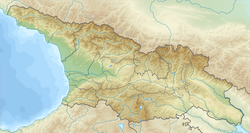Tbilisi
თბილისი Tiflis | |
|---|---|
Top to bottom and left to right: Old Tbilisi and the Narikala Fortress at dusk; Freedom Square; Bridge of Peace and Sioni Cathedral, with Sameba in the background; Old Town as viewed from Metekhi. | |
 | |
 Tbilisi highlighted in Georgia | |
| Coordinates: 41°43′21″N 44°47′33″E / 41.72250°N 44.79250°E | |
| Country | |
| Established | AD 455[2] |
| Government | |
| • Type | Mayor–Council |
| • Body | Tbilisi Sakrebulo |
| • Mayor | Kakha Kaladze (GD)[3] |
| Area | |
| 504.2 km2 (194.7 sq mi) | |
| • Metro | 726 km2 (280 sq mi) |
| Highest elevation | 770 m (2,530 ft) |
| Lowest elevation | 380 m (1,250 ft) |
| Population (2024) | |
| 1,258,526[1] | |
| • Density | 2,496.08/km2 (6,464.8/sq mi) |
| • Metro | 1,485,293 |
| Demonym(s) | Tbilisian Tbiliseli (In Georgian) |
| Population by ethnicity[5] | |
| • Georgians | 89.9% |
| • Armenians | 4.8% |
| • Azerbaijanis | 1.4% |
| • Russians | 1.2% |
| • Yazidis | 1.0% |
| • Others | 1.7% |
| GDP[6] | |
| • Capital city | ₾ 32.2 billion (US$ 11.0 billion) · 1st |
| • Per capita | ₾ 26,769 (US$ 9,200) · 1st |
| Time zone | UTC+4 (Georgian Time) |
| Area code | +995 32 |
| HDI (2024) | 0.837 |
| Website | tbilisi.gov.ge |
Tbilisi (English: /təbɪˈliːsi, təˈbɪlɪsi/ tə-bil-EE-see, tə-BIL-iss-ee;[7] Georgian: თბილისი, pronounced [ˈtʰbilisi] ), in some languages still known by its pre-1936 name Tiflis[a] (/ˈtɪflɪs/ TIF-liss),[7] (Georgian: ტფილისი, romanized: t'pilisi) is the capital and largest city of Georgia, lying on the banks of the Kura River with around 1.2 million inhabitants, which is about a third of the country's population. Tbilisi was founded in the fifth century AD by Vakhtang I of Iberia. Since then, the city has served as the capital of various Georgian kingdoms and republics. Between 1801 and 1917, then part of the Russian Empire, Tiflis was the seat of the Caucasus Viceroyalty, governing both the northern and the southern parts of the Caucasus.[8][9]
Because of its location at the crossroads between Europe and Asia, and its proximity to the lucrative Silk Road, throughout history, Tbilisi has been a point of contention among various global powers. To this day, the city's location ensures its position as an important transit route for energy and trade projects. Tbilisi's history is reflected in its architecture, which is a mix of medieval, neoclassical, Beaux Arts, Art Nouveau, Stalinist, and Modern structures.
Historically, Tbilisi has been home to people of multiple cultural, ethnic, and religious backgrounds, though its population is overwhelmingly Eastern Orthodox Christian. Notable tourist destinations include cathedrals Sameba and Sioni, Freedom Square, Rustaveli Avenue and Agmashenebeli Avenue, medieval Narikala Fortress, the pseudo-Moorish Opera Theater, and the Georgian National Museum. The climate in Tbilisi mostly ranges from 20 to 32 °C (68 to 90 °F) in summer and −1 to 7 °C (30 to 45 °F) in winter.
- ^ "Population by regions". National Statistics Office of Georgia. Retrieved 27 April 2024.
- ^ კონსპექტი საქართველოს ისტორიიდან შედგენილი ა. ქუთათელაძისგან Archived 5 February 2021 at the Wayback Machine. რვეული I. თბილისი, სტამბა წიგნების გამომცემელ ქართველთა ამხანაგობისა, 1900. გვერდი 38.
- ^ "Mayor of Tbilisi". Tbilisi City Hall. Archived from the original on 1 December 2017. Retrieved 20 November 2017.
- ^ "Statistics of Tbilisi Region". National Statistics Office of Georgia. Archived from the original on 28 May 2021. Retrieved 22 July 2018.
- ^ "Ethnic composition of Georgia 2014". Pop-stat.mashke.org. Archived from the original on 20 December 2020. Retrieved 10 February 2022.
- ^ "რეგიონული სტატისტიკა".
- ^ a b Jones, Daniel (2011). Roach, Peter; Setter, Jane; Esling, John (eds.). Cambridge English Pronouncing Dictionary (18th ed.). Cambridge University Press. ISBN 978-0-521-15255-6.
- ^ "Tbilisi: The Immortal City". 24 January 2015. Retrieved 14 July 2023.
- ^ "History of Tbilisi". tbilisi.gov.ge. Retrieved 14 July 2023.
Cite error: There are <ref group=lower-alpha> tags or {{efn}} templates on this page, but the references will not show without a {{reflist|group=lower-alpha}} template or {{notelist}} template (see the help page).










